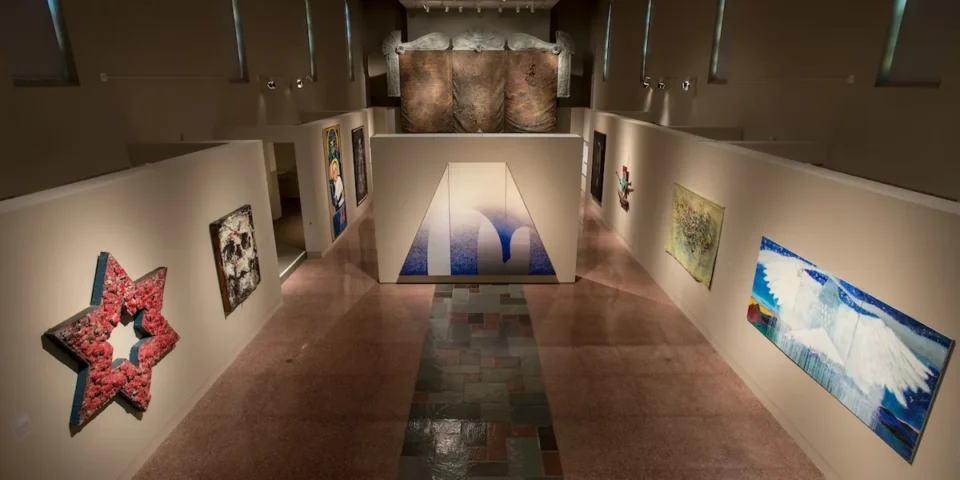In 1993, Saint Louis University opened a new initiative that it touted as the first of its kind—in its words, “the first museum to bring an interfaith focus to contemporary art.” The Museum of Contemporary Religious Art was the brainchild of Fr. Terrence Dempsey, a Jesuit known to joke he was the only person to turn his dissertation into a museum.
That museum, Dempsey explained, was guided by a question alien to many institutions that collect religious art: Why don’t you see what’s going on with artists now, rather than study the artists of the past? By exploring themes of faith, MOCRA brought a unique focus to its exhibits.
Stay up-to-date with the local arts scene
Subscribe to the weekly St. Louis Arts+Culture newsletter to discover must-attend art exhibits, performances, festivals, and more.
We will never send spam or annoying emails. Unsubscribe anytime.
But Dempsey retired last fall, and earlier this year, SLU announced with little fanfare that it would be closing the museum and folding its staff and work into the more traditional Saint Louis University Museum of Art.
Like most universities across the U.S., SLU is dealing with the combination of a declining pool of young American students even as the Trump administration is cracking down on the international students that private universities long relied upon to pay full tuition. Last fall, SLU eliminated 130 positions, and staffers say the university has signaled that more are coming.
Perhaps surprisingly, Jennifer Nutefall, SLU’s dean of university libraries and museums, says the decision was not financial, but rather a question of strategic priorities. “It’s really looking at how to best use our people in the most effective way,” she says. “Consolidating the operations is going to allow us to continue offering high-quality exhibits and programming for the community.”
SLU does not yet have another plan for the building, Nutefall says, something echoed by a university spokesman. The closure, she says, is less about claiming the building and more about better utilizing museum staff. Bringing MOCRA’s tiny staff (one full-time director, along with a part-time employee) under SLUMA is “part of a broader rethinking about what are the best ways that we move forward.”
A new gallery inside SLUMA, the Fr. Terry Dempsey Gallery, will honor MOCRA’s founder. “It is definitely very important for us to continue to honor Fr. Terry Dempsey’s legacy,” Nutefall says, adding that the additional resources freed up by consolidation also create room for a new lecture series being planned for 2027.
Yet some regular visitors to MOCRA mourn what’s being lost.
SLU art history professor Cathleen Fleck is the chair of the university’s Department of Visual & Performing Arts, as well as head of its Arts Council. (The Arts Council was not consulted on the closure, she says.) While she understands MOCRA’s collection will be folded into SLUMA, not having a dedicated museum feels like a loss. She loved the way MOCRA, which existed within what was once a chapel, had a contemplative feeling. The way it welcomed anyone who might stop by is part of a university museum’s mandate: “Its job is to, yes, hold a collection of art, whatever that might be, but also to engage with their university community in whatever ways they can, and then to be open to the broader community as well.”
And while Fleck’s focus is medieval art, she loved finding connections between MOCRA’s exhibits and the historic pieces in her curriculum. She recalls how modern Muslim and Jewish artists’ calligraphy seemed at one with the medieval manuscripts her students study. She also taught medical students how to observe and explain what’s in front of them by taking students to MOCRA, teaching them to observe its exhibits the way they might later be called upon to examine a lesion on a patient’s arm.
She particularly remembers Andy Warhol’s Silver Clouds exhibit, which in 2002 filled all of MOCRA with silvery balloon-like objects. “It was just kind of otherworldly, and I don’t think that they could do that kind of thing at SLUMA,” she says.
Even so, Nutefall says that, overall, people have been understanding. “I definitely understand it’s sad,” she says. “And, you know, in an ideal world there would maybe be a different outcome, but just looking at what’s going on, I would say in all of higher education right now, it’s important to me that we still support the arts and museums, and bringing the collections together, I think will potentially make it more visible going forward.”
As for director David Brinker, he took a philosophical approach in his public note about the museum’s closure, writing in an email sent to past MOCRA patrons that he was taking his cues from the Ignatian practice of the Examen, which expresses “gratitude for the gifts and grace we’ve experienced through the events of the day.”
“I want to stress that the closure of MOCRA is not immediate,” he added. “In the time remaining, we will bring you the same level of innovative and compelling exhibitions and programs that have been the hallmark of MOCRA for over 30 years.” The museum’s current exhibit, Continuum (Continued): Figuration and Abstraction in the MOCRA Collection, runs through May 15.

